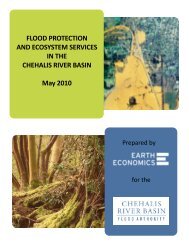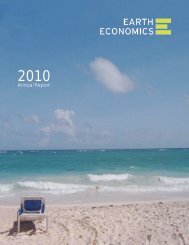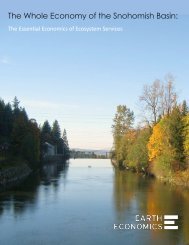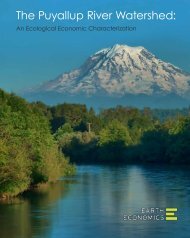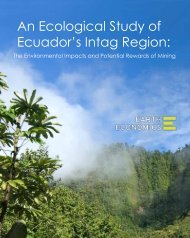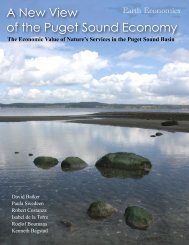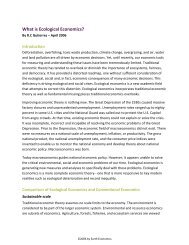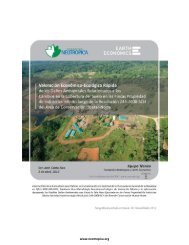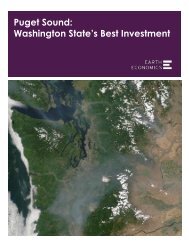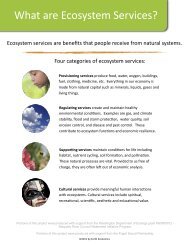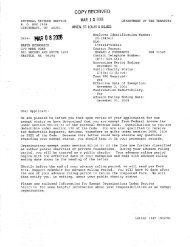The Spot Prawn Fishery: A Status Report - Earth Economics
The Spot Prawn Fishery: A Status Report - Earth Economics
The Spot Prawn Fishery: A Status Report - Earth Economics
You also want an ePaper? Increase the reach of your titles
YUMPU automatically turns print PDFs into web optimized ePapers that Google loves.
<strong>The</strong> <strong>Spot</strong> <strong>Prawn</strong> <strong>Fishery</strong>: A <strong>Status</strong> <strong>Report</strong><br />
ing-processors were not in evidence on the fishing<br />
grounds. Participation by catcher-processors seems<br />
to be increasing, with approximately 60% of the<br />
fleet now having freezers on-board (Love, ADFG.<br />
Pers. comm., May 2001). Catcher-processor numbers<br />
appear to have increased again for the 2000–<br />
01 season, but these data have yet to be confirmed.<br />
<strong>The</strong> ex-vessel value of the fishery at the close of<br />
the 1999–2000 season was estimated at $2.8 million.<br />
Markets remained strong for spot prawns in<br />
2000 and prices were high, but prospects for 2001<br />
appear to have softened as the Japanese economy<br />
continues to slip and the average Japanese income<br />
declines. Markets for spot prawns are cyclical and<br />
considered fluid; fluctuations are not unexpected.<br />
<strong>The</strong> majority of product in the fishery are whole,<br />
sorted, dipped, and frozen-at-sea (FAS) prawns,<br />
which are estimated to sell for $8.00/lb. wholesale<br />
(whole weight), and as high as $70.00/lb. in restaurants.<br />
This year there has already been a 30% decline<br />
in unit price, indicative of the volatility of both the<br />
price and markets for spot prawns (Stephen Wong,<br />
SeaPlus. Pers. comm., June 2001).<br />
<strong>The</strong> frozen-at-sea product type is considered<br />
sashimi grade. Over 90% is sold to Japan. Frozen<br />
spot prawns constitute less than 1% of total<br />
Japanese shrimp imports (Wong, SeaPlus. Pers.<br />
comm., June 2001). According to SeaPlus, which<br />
buys both Alaskan and Canadian spot prawns<br />
(40:60), the US market constitutes 5–10% of spot<br />
prawn production. California is the primary US<br />
market, but product is also sold in Chicago,<br />
Detroit, Denver, Atlanta, and Florida.<br />
<strong>Spot</strong> prawns are the “species of choice” for the<br />
Asian live markets. Fishers throughout southeastern<br />
Alaska devote at least part of their fishing time<br />
to serving the live market (Paust, University of<br />
<strong>Spot</strong> <strong>Prawn</strong> Product<br />
Alaska Marine Advisory Program. Pers. comm.,<br />
June 2001). While the live market is definitely a<br />
high-value market, it is a difficult one to capture.<br />
<strong>The</strong> difficulty, primarily logistical, is due to the<br />
complexity and economics of organizing transportation<br />
and shipping. SeaPlus’ Stephen Wong<br />
said, “Shipping live in volume is an impossibility.<br />
<strong>The</strong> difficulty of establishing effective transportation<br />
linkages poses an enormous risk. <strong>The</strong> profits<br />
from the live market just aren’t great enough to<br />
take that risk.” It is also problematic due to the<br />
possibility of transporting diseases, some of<br />
which may not even have been identified, to<br />
other regions and countries (Love, ADFG. Pers.<br />
comm., June 2001).<br />
Existing Management and<br />
Regulatory Systems<br />
Alaska’s Management Philosophy<br />
<strong>The</strong> Alaska Department of Fish and Game, Division<br />
of Commercial Fisheries, oversees management<br />
and conservation of Alaska’s commercial fisheries.<br />
“<strong>The</strong> mission of the Division of Commercial<br />
Fisheries is to manage, protect, rehabilitate,<br />
enhance, develop fisheries and aquatic plant<br />
resources in the interest of the economy and<br />
general well-being of the State, consistent<br />
with the sustained yield principle and subject<br />
to allocations established through the public<br />
regulatory processes. <strong>The</strong> Division is responsible<br />
for the management of the State’s commercial,<br />
subsistence, and personal use fisheries;<br />
the rehabilitation and enhancement<br />
of existing fishery resources; and the development<br />
of new fisheries. Technical support is<br />
provided to the private mariculture and<br />
salmon ranching industries. <strong>The</strong> Division also<br />
plays a major role in the management of fisheries<br />
in the 200-mile Exclusive Economic<br />
Zone and participates in international fisheries<br />
negotiations.”<br />
(See http://www.cf.adfg.state.ak.us/cf_home.htm)<br />
Regulations, particularly those governing allocation,<br />
are determined by the Alaska Board of<br />
Fisheries, based on recommendations from ADFG<br />
and testimony from commercial, recreational, personal<br />
use, and subsistence users. <strong>The</strong> BOF members<br />
are appointed by the Governor and approved<br />
by the legislature.<br />
Photo Courtesy Stephen Wong, SeaPlus Marketing.<br />
<strong>The</strong> Southeastern Alaska Pot Shrimp<br />
Management Plan<br />
<strong>The</strong> Board of Fisheries implemented a manage-<br />
12



